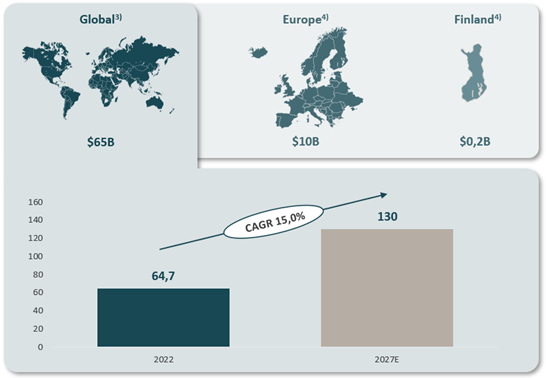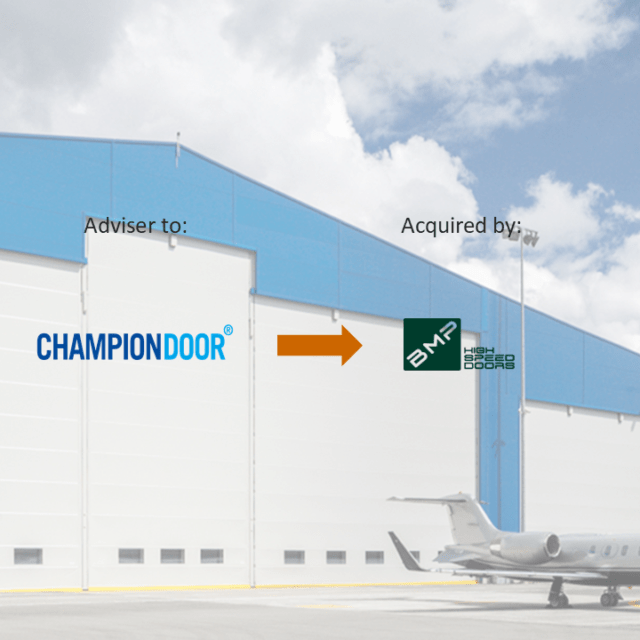The Small and Medium sized Enterprise (SME) segment is one of the fastest growing segments for cloud-based solutions and services due to growing demand for scalability, integration, flexibility, and improved productivity. Cloud-based solutions allow SMEs to compete against large enterprises without high upfront investments. SMEs considering the adoption and implementation of cloud-based ERP systems increasingly demand customization, meaning that vendors need to offer solutions with large enough customization options[1]. Cloud-based ERP solutions offer more cost-effective and flexible solutions compared to on-premises, leading to market share gains for pure cloud vendors. Additionally, adoption of cloud ERP solutions supported by even more international economies and businesses benefitting from cloud connectivity[2].
Global cloud-based Enterprise Resource Planning (ERP) market overview
The global cloud-based ERP market is a fragmented and highly competitive market comprised of both big international players and smaller local companies. The sector is rapidly growing and valued at approximately 65 billion USD and expected to grow by 15,0% and reaching up to 130 billion USD in year 2027[3]. The cloud ERP market has experienced rapid growth due to the increasing adaptation of cloud-based solutions across various industries. In Europe, the industry revenue for cloud-based ERP providers is valued at approximately 10,3 billion USD in year 2022[4].
Cloud-based ERP software allows businesses to manage their operations and resources more efficiently through centralized systems hosted on remote services. The increased adaptation of cloud ERP solutions is due to e.g., flexibility & scalability, cost effectiveness, operational efficiency and ease of multi-country systems. Cloud ERP solutions offer more flexibility and scalability than traditional on-premises solutions, allowing businesses to adjust to changing needs more easily. Additionally, cloud ERP solutions are typically more cost-effective than traditional on-premises solutions as they require less hardware, software, and IT resources.[5] With the rise of global business operations, cloud ERP solutions have become essential for managing operations across multiple locations and geographies.
Global cloud-based ERP market development 2022-2027E

The continuing demand for organizations to improve the efficiency of their operations with the help of advanced technologies is shifting the market for ERP solutions. Cloud-based solutions lower the threshold to adopt technologically advanced solutions to help companies manage their business functions.
The advantages for cloud-based ERP solutions are likely to drive the adaptation of cloud-based ERP solutions and services to carry out core business functions. The ease of use, reduced costs, and flexibility that cloud ERP offers, make them an increasingly attractive alternative for businesses of all sizes. As more organizations look to improve their operations and reduce costs, the demand of cloud ERP systems is expected to continue at a high level.
Globally, the ERP market has evolved significantly over the past years. The current solutions provided by vendors of cloud-based ERP are SaaS-based and PaaS-based. Cloud-based ERP disadvantage has been the limited options for customization[6]. SaaS-based ERP models currently offer some level of customizations as a part of their standard offering, and more and more vendors invest in making their offering more customizable. However, currently solutions requiring heavy customization, especially with respect to major functionalities, can be difficult to find.
When it comes to SMEs considering the adaptation and implementation of cloud-based ERP, customization can be a major hurdle[7]. These limitations in customization are affecting the adaptation of cloud ERP, which makes it important for vendors to work towards offering more flexible and customizable solutions that can meet more and more unique customer needs.
Small and medium-sized enterprises’ role in the global ERP market
Cloud-based ERP solutions have become increasingly popular among small and medium-sized enterprises (SMEs). The SME segment (1 – 1 000 employees) is one of the fastest growing segments for cloud-based solutions and services that improve business performance and productivity. The larger enterprises are still the leading segment in terms of share, mainly due to affordability and its acceptance of emerging technologies. However, cloud-based ERP and MRP systems are growing in demand for SMEs primarily due to scalability, integration, flexibility, and improved productivity[8]. By investing in cloud ERP solutions, SMEs can streamline their business processes, reduce manual data entry, and improve data accuracy, which in turn leads to increased productivity.
Additionally, another significant advantage of cloud-based ERP solutions for SMEs, is that they can reduce manufacturing time. By providing real-time visibility into inventory levels, production schedules, and other order fulfillment, cloud ERP solutions enable SMEs to optimize their manufacturing processes and reduce lead time. Therefore, cloud-based ERP and MRP solutions give SMEs the tools to compete with larger organizations and enhance their business processes.
Looking forward, vendors need to focus on offering more customizable solutions to meet unique customer needs, especially for SMEs. The market is shifting towards advanced technologies that will help companies manage and navigate their business functions more efficiently.
Competitive landscape and overview
The competitive landscape can be split into two main categories: specific manufacturing products and extended accounts systems.
Extended accounts systems, also known as “full-service” packages, have been expanded over time to handle a range of functions, including order processing, inventory control and manufacturing. However, these companies typically serve many industries, meaning that manufacturing may not be their primary focus. As a result, the further these systems move away from their core expertise, the less effective their functions become.
On the other hand, legacy systems developed with client/server technology have sometimes been rebranded as “cloud” solutions by hosting them on virtual machines and offering monthly subscription plans. However, this is not a long-term solution to meet market demands. For a more sustainable approach, it is preferrable to use a pure cloud product that has an open API for building integrations and is part of an “eco-system”, which usually required single sign-on. By using a pure cloud solution, customers can benefit from a more seamless experience that enables easy integration with other applications.
Pontus Kaisti
Analyst
[1] Haddara, M., Gøthesen, S., & Langseth, M. (2022). Challenges of cloud-ERP adoptions in SMEs. Procedia Computer Science, 196, 973-981.
[2] How cloud ERP compares to on-premises ERP – NetSuite
[3] Cloud ERP Market by Component, Business function, organization size and region – Global forecast to 2027, Markets & Markets (2023)
[4] In Europe, the industry revenue for cloud-based ERP providers is valued at ~10,3 billion euro in year 2022 – Nordic Growth analysis, Technology Market Insight and Statista (2023)
[5] How cloud ERP compares to on-premise ERP – NetSuite
[6] Cloud ERP Market by Component, Business function, organization size and region – Global forecast to 2027, Markets & Markets (2023)
[7] Haddara, M., Gøthesen, S., & Langseth, M. (2022). Challenges of cloud-ERP adoptions in SMEs. Procedia Computer Science, 196, 973-981.
[8] Cloud ERP Market by Component, Business function, organization size and region – Global forecast to 2027, Markets & Markets (2023)
















